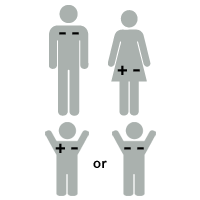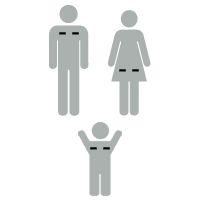Rh Disease
What is Rh disease?
Rh disease occurs during pregnancy when there is an incompatibility between the blood types of the mother and baby.
What causes Rh disease?
Every person has a blood type, (O, A, B, or AB) and an Rh factor, either positive or negative. The blood type and the Rh factor simply mean that a person's blood has certain specific characteristics. The blood type is found as proteins on red blood cells and in body fluids. The Rh factor is a protein that is found on the covering of the red blood cells. If the Rh factor protein is present on the cells, the person is Rh positive. If there is no Rh factor protein, the person is Rh negative.
Rh factors are genetically determined. A baby may have the blood type and Rh factor of either parent, or a combination of both parents. Rh factors follow a common pattern of genetic inheritance. The Rh positive gene is dominant (stronger) and even when paired with an Rh negative gene, the positive gene takes over. For example:
-
If a person has the genes + +, the Rh factor in the blood will be positive.
-
If a person has the genes + -, the Rh factor will be positive.
-
If a person has the genes - -, the Rh factor will be negative.
A baby receives one gene from the father and one from the mother.
|

|
If a father's Rh factor genes are + +, and the mother's are + +, the baby will have one + from the father and one + gene from the mother. The baby will be + + Rh positive.
|
|
|
|

|
If a father's Rh factor genes are + +, and the mother's are - -, the baby will have one + from the father and one - gene from the mother. The baby will be + - Rh positive.
|
|
|
|

|
If the father's genes are + - Rh positive, and the mother's are + - Rh positive, the baby can be:
-
+ + Rh positive
-
+ - Rh positive
-
- - Rh negative
|
|
|
|

|
If the father's genes are - -, and the mother's are + -, the baby can be:
-
+ - Rh positive
-
- - Rh negative
|
|
|
|

|
If the father's genes are - -, and the mother's are - -, the baby will be:
|
Problems with the Rh factor occur only when the mother's Rh factor is negative and the baby's is positive.
Why is Rh disease a concern?
When an Rh negative mother has a baby that is Rh positive, problems can develop if the baby's red blood cells cross to the Rh negative mother. This usually happens at delivery when the placenta detaches. It may also happen, however, anytime blood cells of the two circulations mix such as during a miscarriage, with a fall, or during an invasive prenatal testing procedure such as an amniocentesis or chorionic villus sampling.
The mother's immune system sees the baby's Rh positive red blood cells as foreign. Just as when bacteria invade the body, the immune system responds by developing antibodies to fight and destroy these foreign cells. The mother's immune system keeps the antibodies in case the foreign cells appear again, even in a future pregnancy. The mother is now Rh sensitized.
Although it is not as common, a similar problem of incompatibility may happen between the blood types (A, B, O, AB) of the mother and baby in the following situations:
|
Mother's Blood Type
|
O
|
A
|
B
|
|
Baby's Blood Type
|
A or B
|
B
|
A
|
In a first pregnancy, Rh sensitization is not likely. Usually it only becomes a problem in a future pregnancy with another Rh positive baby. During that pregnancy, the mother's antibodies cross the placenta to fight the Rh positive cells in the baby's body. As the antibodies destroy the red blood cells, the baby can become anemic. The anemia can lead to other complications including jaundice and organ enlargement.
Rh disease is also called erythroblastosis fetalis during pregnancy. In the newborn, the resulting condition is called hemolytic disease of the newborn (HDN).
Some of the more common complications of Rh disease for the fetus and newborn baby include the following:
-
Anemia (in some cases, the anemia is severe with enlargement of the liver and spleen)
-
Jaundice--yellowing of the skin, eyes, and mucous membranes.
-
Severe anemia with enlargement of the liver and spleen
-
Hydrops fetalis--this occurs as the fetal organs are unable to handle the anemia. The heart begins to fail and large amounts of fluid build up in the fetal tissues and organs. A fetus with hydrops fetalis is at great risk of being stillborn.
After birth, the red blood cell destruction may continue. Problems may include the following:
-
Severe jaundice
The baby's liver is unable to handle the large amount of a substance called bilirubin that results from red blood cell breakdown. The baby's liver is enlarged and anemia continues.
-
Kernicterus
The most severe form of too much bilirubin and results from the build up of bilirubin in the brain. This can cause seizures, brain damage, deafness, and death.
What are the symptoms of Rh disease?
A mother has no physical signs of Rh disease, but her Rh positive baby can have problems if the mother has developed antibodies. The following are the most common symptoms of Rh disease in the fetus. However, each pregnancy may have different symptoms of the condition. Symptoms may include:
-
With amniocentesis, the amniotic fluid may have a yellow coloring and contain bilirubin.
-
Ultrasound of the fetus shows enlarged liver, spleen, or heart and fluid build up in the fetus' abdomen.
The symptoms of Rh disease may resemble other conditions or medical problems. Always consult your doctor for a diagnosis.
How is Rh disease diagnosed?
Early identification of the Rh negative mother is very important. Then, the risks for the baby can be determined by blood testing of both parents (Rh negative mother, Rh positive father). The disease may be diagnosed if a previous pregnancy resulted in an Rh positive baby. In addition to a complete medical history and physical examination, diagnostic procedures for Rh disease may include:
-
Testing the presence of Rh positive antibodies in the mother's blood
-
Ultrasound--to detect organ enlargement or fluid build up in the fetus. Ultrasound is a diagnostic imaging technique which uses high-frequency sound waves and a computer to create images of blood vessels, tissues, and organs. Ultrasounds are used to view internal organs as they function, and to assess blood flow through various vessels.
-
Amniocentesis--to measure the amount of bilirubin in the amniotic fluid. Amniocentesis is a test performed to determine chromosomal and genetic disorders and certain birth defects. The test involves inserting a needle through the abdominal and uterine wall into the amniotic sac to retrieve a sample of amniotic fluid.
-
sampling of some of the blood from the fetal umbilical cord during pregnancy to check for antibodies, bilirubin, and anemia in the fetus.
Treatment for Rh disease
Specific treatment for Rh disease will be determined by your doctor based on:
-
Your pregnancy, overall health, and medical history
-
Extent of the disease
-
Your tolerance for specific medications, procedures, or therapies
-
Expectations for the course of the disease
-
Your opinion or preference
Treatments for Rh disease may include:
-
Intrauterine blood transfusion of red blood cells into the baby's circulation--a procedure that is performed by placing a needle through the mother's uterus and into the abdominal cavity of the fetus or directly into the vein in the umbilical cord. It may be necessary to give a sedative medication to keep the baby from moving. Intrauterine transfusions may need to be repeated.
-
Early delivery, if the fetus develops complications (if the fetus has mature lungs, labor and delivery may be induced to prevent worsening of the disease)
Prevention of Rh disease
Fortunately, HDN is a very preventable disease. Because of the advances in prenatal care, nearly all women with Rh negative blood are identified in early pregnancy by blood testing. If a mother is Rh negative, she will be tested for Rh antibody titers. If she has not been sensitized, she is usually given a drug called Rh immunoglobulin (RhIg), also known as RhoGAM. This is a specially-developed blood product that can prevent an Rh negative mother's antibodies from being able to react to Rh positive cells. Many women are also given RhIg around the 28th week of pregnancy. After the baby is born, a woman should receive a second dose of the drug within 72 hours.
RhIg destroys any anti-Rh antibodies that enter in the mother's circulation before her immune system becomes sensitized. This helps protect a future Rh positive baby.